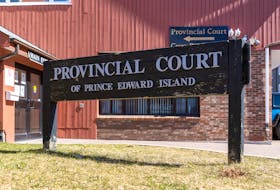It was the greatest tragedy in the history of Prince Edward Island.
That's how Island historian Georges Arsenault described the 1758 Acadian expulsion, which tore families apart and resulted in the deaths of about half of the 3,000 deported, during an Acadian Remembrance Day ceremony on Sunday.
The most tragic day of the expulsion had occurred on Dec. 13, 1758, exactly 257 years prior to the ceremony, with the sinking of the Duke William.
However, there were many more who also suffered, said Arsenault.
"There were three boats that went down, many died of disease on the boats and many others died when they arrived in France," said Arsenault, who also served as master of ceremonies. "It's the greatest tragedy in the history of the Island and one of the greatest in the history of Canada."
The eighth annual event was hosted by the Societe Saint-Thomas-d'Aquin (SSTA) and Parks Canada at Port-la-Joye and Fort Amherst National Historic Site.
Guy LaBonté, president of the SSTA, said the day is more than commemorating the tragedies and courage of Acadians.
"It is also an occasion to celebrate the vitality, perseverance and value of our people," he said.
An indoor ceremony was followed by a procession to the Acadian Odyssey Monument, which marks the site of the first permanent European settlement on P.E.I. where three hundred French settlers arrived in the province in 1720.
The long relationship between the Acadian and Mi'kmaq cultures was also celebrated.
Arsenault noted that orally passed down stories have described the Mi'kmaq as having helped some Acadians escape the expulsion.
"Either by staying on the mainland or helping them hide in the woods," he said.
Chief Brian Francis of the Abegweit First Nation, also spoke on the relationship between the two cultures.
While they spoke different languages and wore different clothes, Francis said the two cultures focused on the factors that united them.
"When they (Acadian settlers) desperately needed the hand of friendship, it was extended by the Mi'kmaq... a relationship was built first out of necessity and nurtured through trade and transaction, it blossomed into a friendship that continues to this day," he said. "These actions not only defined our proud heritage, these ideologies formed the bedrock of what it means to be a Canadian."
The ceremony ended with the signing of a tripartite memorandum of understanding between the Société Nationale de l'Acadie, Parks Canada and Canadian Heritage to facilitate Acadian cultural projects at national historic sties and parks throughout the Atlantic provinces.
The five-year agreement will encourage promotion of Acadian culture, history and artistic events, including festivities during the 150th anniversary of Canada in 2017.
René Cormier, president of the Société Nationale de l'Acadie, said the agreement heralds a new era in collaboration.
"(It) will create an environment where all Acadians will have the opportunity to fully benefit from creative experiences to celebrate their culture, history and heritage," said Cormier. "Canadians will also have opportunities to learn more about Acadie and celebrate the inestimable contribution of the Acadian people to Canada's development."
It was the greatest tragedy in the history of Prince Edward Island.
That's how Island historian Georges Arsenault described the 1758 Acadian expulsion, which tore families apart and resulted in the deaths of about half of the 3,000 deported, during an Acadian Remembrance Day ceremony on Sunday.
The most tragic day of the expulsion had occurred on Dec. 13, 1758, exactly 257 years prior to the ceremony, with the sinking of the Duke William.
However, there were many more who also suffered, said Arsenault.
"There were three boats that went down, many died of disease on the boats and many others died when they arrived in France," said Arsenault, who also served as master of ceremonies. "It's the greatest tragedy in the history of the Island and one of the greatest in the history of Canada."
The eighth annual event was hosted by the Societe Saint-Thomas-d'Aquin (SSTA) and Parks Canada at Port-la-Joye and Fort Amherst National Historic Site.
Guy LaBonté, president of the SSTA, said the day is more than commemorating the tragedies and courage of Acadians.
"It is also an occasion to celebrate the vitality, perseverance and value of our people," he said.
An indoor ceremony was followed by a procession to the Acadian Odyssey Monument, which marks the site of the first permanent European settlement on P.E.I. where three hundred French settlers arrived in the province in 1720.
The long relationship between the Acadian and Mi'kmaq cultures was also celebrated.
Arsenault noted that orally passed down stories have described the Mi'kmaq as having helped some Acadians escape the expulsion.
"Either by staying on the mainland or helping them hide in the woods," he said.
Chief Brian Francis of the Abegweit First Nation, also spoke on the relationship between the two cultures.
While they spoke different languages and wore different clothes, Francis said the two cultures focused on the factors that united them.
"When they (Acadian settlers) desperately needed the hand of friendship, it was extended by the Mi'kmaq... a relationship was built first out of necessity and nurtured through trade and transaction, it blossomed into a friendship that continues to this day," he said. "These actions not only defined our proud heritage, these ideologies formed the bedrock of what it means to be a Canadian."
The ceremony ended with the signing of a tripartite memorandum of understanding between the Société Nationale de l'Acadie, Parks Canada and Canadian Heritage to facilitate Acadian cultural projects at national historic sties and parks throughout the Atlantic provinces.
The five-year agreement will encourage promotion of Acadian culture, history and artistic events, including festivities during the 150th anniversary of Canada in 2017.
René Cormier, president of the Société Nationale de l'Acadie, said the agreement heralds a new era in collaboration.
"(It) will create an environment where all Acadians will have the opportunity to fully benefit from creative experiences to celebrate their culture, history and heritage," said Cormier. "Canadians will also have opportunities to learn more about Acadie and celebrate the inestimable contribution of the Acadian people to Canada's development."









